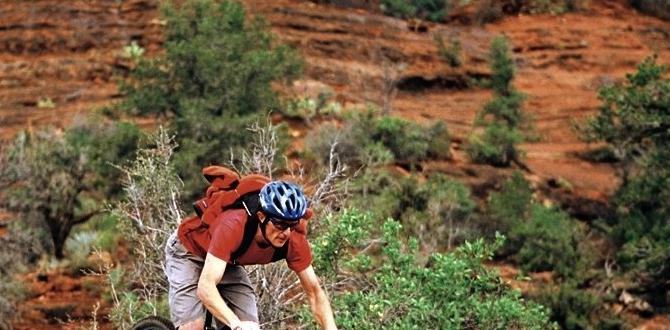The best time to visit Arches National Park without crowds is during the shoulder seasons: April to May and September to October. These months offer pleasant weather and fewer visitors than the peak summer months, providing a more enjoyable and less congested experience.
Arches National Park is a truly magical place. The towering sandstone arches and dramatic desert landscapes attract visitors from all over the world. But if you’re dreaming of exploring this natural wonder without bumping elbows with fellow travelers, timing is everything.
Many find it frustrating to plan a trip only to discover overwhelming crowds. But don’t worry! With a little insider knowledge, you can find those perfect sweet spots to experience the awe of Arches in peace. This guide will walk you through when to go to minimize crowds, maximize your enjoyment, and make your trip truly unforgettable.
Your Guide to Beating the Crowds at Arches National Park
Arches National Park is one of Utah’s most popular destinations, and for good reason. Its iconic Delicate Arch, Landscape Arch, and the Windows Section draw millions of visitors each year. However, experiencing these wonders often comes with significant crowds, especially during peak seasons. Understanding the ebb and flow of visitor traffic is key to planning a more serene visit.
Understanding Arches National Park Visitor Patterns
Visitor numbers at Arches National Park fluctuate significantly throughout the year. The summer months, from June to August, are the busiest due to school holidays and generally favorable weather across much of the country. Spring (March-May) and Fall (September-November) see a surge in visitors as well, but typically less intense than the summer. Winter (December-February) sees the fewest visitors, but weather can be a significant factor.
The National Park Service provides valuable data on visitation. For instance, in 2023, Arches National Park saw over 1.5 million recreation visits. You can explore more detailed visitation statistics on the National Park Service’s official website to get a better sense of historical trends.
The Sweet Spot: Shoulder Seasons for a Peaceful Visit
The strategy for avoiding crowds at Arches National Park hinges on visiting during the “shoulder seasons.” These periods offer a fantastic balance of pleasant weather and significantly fewer people.
Spring: A Budding Season of Serenity
When to Consider Spring:
Early Spring (March): While March can still have some wintery days, especially at the beginning of the month, it generally sees moderate crowds. The landscapes are starting to come alive, and daytime temperatures are often comfortable for hiking.
Late Spring (April – May): This is arguably one of the best times. The desert wildflowers begin to bloom, painting the landscape with vibrant colors. The weather is typically warm and sunny during the day, perfect for exploring, and cooler in the evenings. Crowds are present but usually manageable, especially if you visit on weekdays and arrive early.
What to Expect in Spring:
Pros: Mild weather, blooming desert flora, fewer crowds than summer, beautiful light for photography.
Cons: Can still experience some unpredictable weather (wind, occasional rain or snow), wildflowers may not bloom uniformly, popular spots can still get busy mid-day.
For a truly immersive spring experience, consider booking accommodations well in advance, as even the shoulder season can fill up quickly. Understanding the [weather patterns in Arches] is crucial for packing appropriately.
Autumn: A Golden Hued Escape
When to Consider Autumn:
Early Autumn (September): September is another prime month. The intense heat of summer subsides, making hiking much more enjoyable. The crowds begin to thin out after the Labor Day holiday.
Late Autumn (October – November): October offers crisp air and stunning fall colors (though the desert doesn’t have deciduous trees, the changing scrub oak can be beautiful). November continues this trend with even fewer visitors. Be aware that by late November, temperatures can drop significantly, and snow is possible.
What to Expect in Autumn:
Pros: Comfortable temperatures for hiking, beautiful golden light, significantly reduced crowds compared to summer, less dust than in late summer.
Cons: Shorter daylight hours, potential for colder temperatures and early snow in late October and November, some services might start to scale back towards late November.
Visiting during these shoulder months allows you to experience the grandeur of Arches without feeling rushed or overwhelmed. For example, seeing the sunrise hit Double Arch or the sunset paint Park Avenue can be a much more intimate experience when you’re not surrounded by hundreds of others.
Dates to Avoid (If Crowds Are Your Biggest Concern)
If your absolute priority is to avoid crowds, certain times of the year are best avoided.
Peak Summer (June, July, August): These are the busiest months by far. Expect long lines for park entry, crowded trails, and full parking lots at popular viewpoints. The heat can also be extreme, making daytime hiking challenging.
Major Holidays and Spring Break (Late March – Early April, Thanksgiving Week, Christmas/New Year’s): Even outside of summer, holidays and school breaks bring a significant influx of visitors. Areas like Delicate Arch viewpoint and the Windows Section can become exceptionally crowded.
Specific Dates to Reconsider:
Memorial Day Weekend: The unofficial start of summer, always a busy holiday weekend.
Fourth of July Week: Leading up to and including Independence Day.
Labor Day Weekend: The unofficial end of summer, also a very busy period.
Spring Break Weeks: Often fall in late March and early April, coinciding with good weather and school holidays.
Christmas and New Year’s: While cold, people still visit around the holidays.
The park often implements timed entry systems during peak seasons to manage visitor flow. While this helps, it doesn’t eliminate crowds, just spreads them out. Keeping an eye on the [Arches National Park Timed Entry page] is essential when planning a visit during busy periods.
Planning Your Visit for Fewer People
Beyond simply choosing the right season, there are strategic ways to minimize your exposure to crowds once you’re at the park.
Weekdays are Your Friend
If possible, plan your visit for Monday through Thursday. Weekends, especially Sundays, tend to see a higher volume of visitors who might be starting or ending their trips.
Embrace the Early Bird and Night Owl Strategies
The most popular times in the park are typically between 10 AM and 3 PM.
Morning Magic: Arrive at the park entrance before 8 AM, or even earlier if you can manage it. This allows you to get into the park and to your desired trailhead or viewpoint before the main rush. Many iconic hikes, like the one to Delicate Arch, are best experienced in the early morning light when crowds are minimal.
Evening Adventures: For those who enjoy a bit of twilight, heading out in the late afternoon (after 3 PM) can also significantly reduce crowds. You can catch the “golden hour” light on the rock formations. Just be sure to have headlamps for your hike back if you stay out past sunset, and always be aware of your surroundings and the time.
Consider Less-Trafficked Areas
Arches National Park has many incredible sights, and not all of them are as famous as Delicate Arch.
Balanced Rock: Often crowded, but nearby less-visited loops can offer similar beauty.
The Windows Section: Popular, but if you hike a little further on side trails, you can find quieter spots.
Fiery Furnace: Requires a permit or ranger-led tour and can feel more secluded if you opt for a tour outside peak times.
Primitive Trails: For the more adventurous, areas like Klondike Bluffs or Salt Valley have fewer visitors and offer a rugged, remote experience.
Using Timed Entry Effectively
If Arches National Park is implementing a timed entry permit system for your visit, understand how it works.
Book in Advance: These permits often sell out quickly. Monitor the official [recreation.gov] website for release dates and times.
Choose Your Slot Wisely: Opt for the earliest entry slots (if available) to maximize your time before crowds build, or consider later slots if you plan to stay into the evening.
What to Pack for Your Arches Adventure
Packing right ensures comfort and preparedness, no matter when you visit. Even in pleasant weather, desert conditions can be demanding.
Essential Gear for Arches:
Sturdy Hiking Shoes: Essential for navigating rocky and uneven terrain.
Sun Protection: Wide-brimmed hat, sunglasses, and high-SPF sunscreen are a must. The desert sun is intense.
Plenty of Water: Carry more water than you think you’ll need. Dehydration is a serious risk. Hydration packs or multiple water bottles are recommended.
Snacks: Energy bars, trail mix, and fruits will keep you fueled.
Layered Clothing: Temperatures can swing dramatically between day and night, and with elevation changes. Lightweight, breathable layers are key.
First-Aid Kit: For minor scrapes and blisters.
Headlamp or Flashlight: Crucial if you plan for sunrise or sunset hikes.
For travelers who may require them, comfortable and reliable adult diapers or child diapers can significantly enhance peace of mind and comfort during strenuous hikes or long days exploring. Ensuring you have discreet, absorbent options can make a world of difference for uninterrupted enjoyment of the park’s beauty.
Sample Packing List for a Day Hike:
| Item | Description |
| Comfort & Safety | |
| Backpack | Daypack for carrying essentials |
| Water Bottles/H2O Pack | Minimum 3 liters per person |
| Sunscreen | SPF 30 or higher |
| Hat | Wide-brimmed |
| Sunglasses | UV protection |
| Lip Balm | With SPF |
| First-Aid Kit | Band-aids, antiseptic wipes, pain relievers, blister treatment |
| Clothing | |
| Hiking Boots | Broken-in and comfortable |
| Moisture-Wicking Socks | Prevents blisters |
| Hiking Pants/Shorts | Lightweight and quick-drying |
| T-shirt | Moisture-wicking material |
| Light Jacket/Fleece | For cooler mornings/evenings |
| Rain Gear | Light, packable waterproof jacket |
| Other Essentials| |
| Snacks | High-energy, non-perishable |
| Camera | To capture the majestic scenery |
| Phone | Fully charged, with offline maps |
| Headlamp/Flashlight | If hiking near dawn or dusk |
| Optional | |
| Trekking Poles | For stability on uneven terrain |
| Binoculars | For distant wildlife or landscape details |
| Field Guide | For identifying plants and animals |
When is the Absolute Best Time for Zero Crowds?
If your goal is to experience Arches with the absolute fewest people possible, consider visiting in late January or February. The weather can be cold, with temperatures often below freezing, and snow is possible, but the scenery is still breathtaking. You are far more likely to have sections of the park almost entirely to yourself. However, be prepared for winter driving conditions, limited services, and shorter daylight hours.
A secondary option for minimal crowds would be mid-November through mid-December, before the Christmas rush. Again, cold weather is a factor, but you’ll encounter very few other visitors.
Frequently Asked Questions
Q1: Is it possible to visit Arches National Park and see Delicate Arch without crowds?
A1: Yes, it’s possible by visiting very early in the morning (before 8 AM, ideally before sunrise) or late in the afternoon, especially during the shoulder seasons (April-May, September-October). Weekdays are also much less crowded than weekends.
Q2: What is the weather like in the shoulder seasons at Arches?
A2: Spring (April-May) and Autumn (September-October) typically offer pleasant temperatures, ranging from cool mornings and evenings to warm afternoons. Expect them to be mild and sunny, though wind and occasional rain showers are possible.
Q3: Do I need a timed entry permit to get into Arches National Park?
A3: Arches National Park often requires a timed entry permit during its busiest periods. Always check the official [Arches National Park website] or [recreation.gov] for current requirements and to book your permit in advance, as they can sell out.
Q4: How early should I arrive to avoid crowds at the park entrance?
A4: To significantly reduce your wait time and avoid the largest crowds, aim to arrive at the park entrance before 8 AM, or even earlier if you want to experience popular spots with near-solitude, especially during peak seasons or holidays.
Q5: What are some less crowded hikes in Arches National Park?
A5: Consider trails like the Klondike Bluffs trail, Fiery Furnace (with a permit or ranger tour), or exploring areas like Salt Valley. Even popular trails like those in the Windows Section can offer a quieter experience if you venture onto the lesser-used side paths.
Q6: Is Arches National Park open year-round?
A6: Yes, Arches National Park is open year-round. However, visitor services may be reduced during the winter months, and road access can be affected by snow and ice.
Q7: What should I bring for a day of hiking in Arches to stay comfortable?
A7: Essential items include plenty of water (at least 3 liters per person), sun protection (hat, sunglasses, sunscreen), sturdy hiking shoes, layered clothing you can add or remove, and high-energy snacks. A basic first-aid kit is also recommended.







